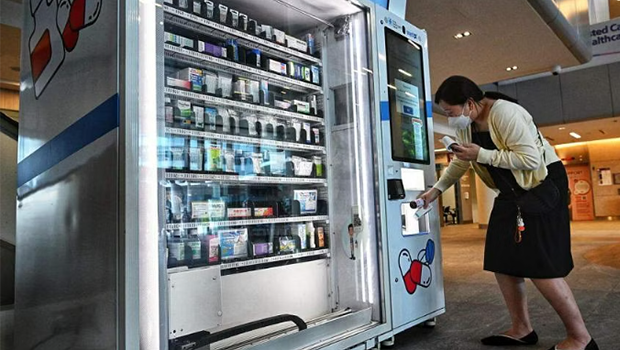HealthXchange will NEVER ask you to transfer money over a call. If in doubt, call the 24/7 ScamShield helpline at 1799, or visit the ScamShield website at www.scamshield.gov.sg.

The vending machine at Changi General Hospital lets patients get both over-the-counter and pharmacy-only medicine quickly. ST PHOTO: CHONG JUN LIANG
Patients can now purchase pharmacy-only medicine from a vending machine following teleconsultation, in a pilot project at Changi General Hospital (CGH).
Launched in April, the Pharmacy Smart Interface System (PharmaSIS) vending machine is among a few technological solutions implemented by the hospital to improve the efficiency of its pharmacists, while making it more convenient for patients to obtain medication for minor ailments.
In May, over 100 patients used PharmaSIS to buy their medicine.
The user-friendly machine allows patients to obtain both over-the-counter (OTC) and pharmacy-only medicine quickly.
While OTC drugs can be bought without teleconsultation, the latter can be dispensed only under the supervision of a pharmacist who is available from 9am to 6pm on weekdays.
At the vending machine, customers first key their name and phone number into the system before receiving a call from the pharmacist on duty.
Identification must be produced for record purposes, though patient details will not be stored in the machine system.
After the consultation, the pharmacist prescribes the appropriate drug and dosage for the patient, and the medicine is added to the cart for a smooth checkout process.
The pharmacist closely monitors the drugs being dispensed through a video camera in the machine. This is to ensure that the right medication has been given, in line with regulatory requirements by the Health Sciences Authority.
PharmaSIS is part of a wider scheme at CGH to redeploy its pharmacists to other areas of patient care. Rather than being cooped up behind a counter, pharmacists are freed up to do other tasks in between sales, such as clinical work.
"We want to optimise resources," said Dr Jonathan Seah, head of pharmacy at CGH. "We want to position our pharmacists to be able to take care of more complicated patients."
Besides PharmaSIS, the hospital has also introduced an automated drug storage and retrieval system that has been estimated to save around 16,000 man hours a year.
ntroduced in 2018, the Outpatient Pharmacy Automation System makes use of robot arms to retrieve medication, which is packed and tagged in bins according to drug type, expiration date and batch number.
The drugs collected are then assembled by a pharmacist who will dispense them to patients at the counter.

A pharmacist at Changi General Hospital using the Outpatient Pharmacy Automation System to retrieve drugs before dispensing them. ST PHOTO: CHONG JUN LIANG
Previously, pharmacists had to walk from shelf to shelf to retrieve medication in a time-consuming and tiring process. With the help of robots, picking up and dropping off drugs can be done within 16 seconds.
Currently, PharmaSIS is found only at CGH Medical Centre, but the public can look forward to it being made available in the larger Simei neighbourhood and Changi area in time to come.
Get the Health Buddy App
© 2025 SingHealth Group. All Rights Reserved.













 Get it on Google Play
Get it on Google Play